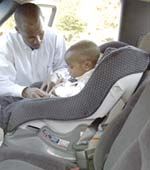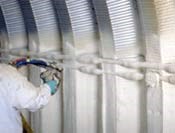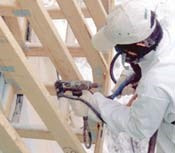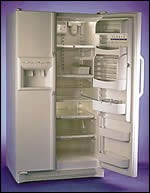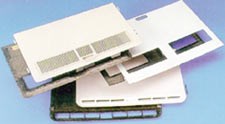Urethane Foams Move from HCFCs To "Cleaner" Blowing Agents
The future has arrived for polyurethane foams.
The future has arrived for polyurethane foams. January 1 brought the first of several crucial deadlines imposed by the Montreal Protocol. It terminated production of HCFC-141b, up to now the leading blowing agent for rigid PUR foam insulation in North America. U.S. EPA rules allow use of remaining stocks of 141b in foams until Jan. 1, 2005. Production of two other HCFCs, 22 and 142b, is allowed until Jan. 1, 2007, but they are not widely used in PUR foams.
The polyurethanes industry has been preparing for this transition for some time. Major segments of the rigid foam market—construction, appliances and automotive—are already well into conversion to alternative blowing agents. They have been helped significantly by R&D efforts that have improved foam performance with the new alternatives and have lowered formulation costs. Raw-material suppliers have come up with new polyols, surfactants, catalysts, flame retardants, and other additives optimized to work with the alternative blowing agents. These and other innovations were highlighted at the recent Polyurethanes 2002 Conference in Salt Lake City, sponsored by the Alliance for the Polyurethane Industry (API).
Conversion well advanced
In North America, most flexible-faced laminators are converting to pentanes, while most appliance makers have switched to non-flammable HFC-245fa. This HFC is a compelling choice due to its low thermal conductivity, which helps meet the new appliance energy requirements of the Dept. of Energy.
HFC-245fa is also gaining use in sprayed roofing and insulation foams. HFC-245fa offers fewer conversion challenges than pentanes or low-boiling blowing agents. But because of its high cost, most formulators minimize use of 245fa by adding high levels of water.
Neither HFC-245fa nor pentanes alone can offer both the physical properties and low cost of HCFC-141b, which sells for $1.20/lb. HFC-245fa currently costs about $4.50/lb. (Honeywell, the sole North American producer of HFC-245fa, is due to progress from pilot-plant to commercial production in the second half of 2003.) Hydrocarbons range in cost from 20¢/lb for pure n-pentane to 75¢/lb for the cyclopentane/isopentane blends now in favor. Pentanes’ flammability and large upfront conversion costs have posed the main challenge.
However, there have been significant strides toward matching or exceeding the performance of HCFC-141b at comparable cost through blending HFC-145fa with water or pentane and using new polyol formulations.
Successes with HFC-245fa
Honeywell reported on recent field evaluations of its Enovate 3000 HFC-245fa in construction foams. Spray-foam trials with several major systems houses over the last couple of years demonstrate that a blowing-agent system consisting of approximately 30 to 50 mole % HFC-245fa and the remainder water is viable for roofing and residential or commercial wall-cavity spray foam. The trials were run in locations that represent the extremes of ambient conditions—from the hot, dry Southwest to the damp, warm Southeast to the cool, damp upper Midwest and even the cold of Montreal in January. Honeywell reports that the foam exhibited excellent laydown on vertical and horizontal surfaces using both hand and robotic spraying techniques. The foam had a good rise profile, knitted well with adjacent passes, and had a smooth surface.
Spray foam co-blown with a 50/50 mole ratio of HFC-245fa and water has a finished cost about equal to that of HCFC-141b spray formulations, even though the liquid system costs more per pound. The reason is that foam yields with HFC-245fa plus water are 8% to 15% better than with HCFC-141b due to thinner skins and more consistent density across the sample. Cost/R (cost per insulation value) is also equal to that with 141b. Cost-effectiveness is even better at a 30/70 245fa/water ratio.
Huntsman Polyurethanes re ported on its new mannich-based polyol designed for spray-foam roofing and insulation with HFC-245fa/water blends. Jeffol R-315X features a lower hydroxyl level (325 OH) and lower viscosity (2500 cp) than other mannich polyols. Field trials show this mannich polyol based on propylene oxide has the best overall performance in terms of physical properties and processing in all-water-blown foams, whereas polyols containing ethylene oxide tend to produce soft foams with poor dimensional stability.
Field trials of co-blown HFC-245fa/water foams containing Jeffol R-315X under a variety of environmental and processing conditions produced high-quality foam with good surface texture, easy processability, and good yield, Huntsman claims. Similar results were obtained with HFC-134a or pentane, although use of pentane required some optimization.
Oxid L.P. has a novel polyester polyol with a higher hydroxyl number, functionality, and aromatic content than conventional polyester polyols. Terol 708 is designed for PUR or PIR spray and discontinuous pour-in-place foams. It reportedly yields improved compressive strength and demold time. Its high functionality allows for higher loading of the polyol, which enhances foam fire resistance.
Oxid reported on field trials with a co-blown HFC-245fa/water spray-foam roofing system that contained 1.2% water and 38% Terol 708. HFC-245fa was limited to 10 pph of total polyol in order to make the cost of the formulation approach that of a typical HCFC-141b foam and to keep the drum pressure low. Triethyl phosphate was the flame retardant.
The resulting foam reportedly sprayed well with a smooth rise and no creep. It showed a smooth surface and very good interlaminar adhesion. The foam’s initial K factor was 0.15, which is much better than all-water foams, Oxid says. Compared with a foam containing Terol 256 (Oxid’s previous highest-functionality, high-aromatic-content polyester polyol), the foam with Terol 708 had lower flame spread and smoke index. Even at lower density, the foam with Terol 708 had better overall dimensional stability.
Pentane in PIR boards
Although a majority of PIR boardstock producers have moved to pentane, it may not be the ideal blowing-agent solution. An inherent problem is pentane’s relatively high boiling point. At ambient temperatures around 72 F or below, pentane can condense in the foam cells, resulting in loss of foam insulation properties and dimensional stability.
Honeywell conducted trials in which small amounts of HFC-245fa were added to pentane-blown formulations to improve the foam’s low-temperature performance. Adding only 2 mole % of HFC-245fa to pentane led to a significant improvement in K-factor at all temperatures. At 10 mole % HFC-245fa, K-factor improved still more. Unlike 100%-pentane controls, the 245fa blends showed no deterioration at low temperatures due to condensation of the blowing agent.
Honeywell developed a cost model using 100% isopentane-blown foam as a basis for comparison. Adding 2 mole % of HFC-245fa provides a 3% improvement in K-factor at 75 F and a 4.5% improvement at 45 F. The cost impact per board foot of foam is minimal. The cost/R is actually a few percent lower than using neat isopentane. The analysis is similar for 10 mole % of 245fa, but the improvement in performance is much more dramatic: Foam K-factor is improved by more than 5% at 75 F and by 10% at 40 F. This gain is obtained at a cost penalty of less than 4%. On a cost/R basis, Honeywell says this technology can be more economical than neat isopentane.
Burn testing pentane foam
AtoFina Chemicals addressed the need for improved fire performance in pentane-blown PIR foams by investigating the use of two liquid hydrochlorocarbons, 1,1-dichloroethane (D-11) and trans-1,2-dichloroethylene (Trans 12) as co-blowing agents with pentane. Small-scale flame tests show a significant improvement in fire resistance when about 25 mole % of D-11 or Trans 25 is used with 75% pentane.
For example, the Mobil 45 test shows that the weight loss of foams containing 25/75 D-11/pentane is about 40% less than a corresponding all-cyclopentane foam. Similar results were obtained when D-11 was used with n-pentane, isopentane, or a 50/50 cyclo/isopentane blend.
Albemarle Corp. has developed a new intermediate-scale burn-test device to simulate the Factory Mutual FM 4450 large-scale roof-burn calorimeter test, which has been difficult for flexible-faced laminates to pass when they use pentane blowing agents. The new device is intended to permit realistic screening of experimental foams before spending substantial sums on the large-scale test. Albemarle has used this new tool to develop a flame-retardant package that can be optimized for the FM 4450 calorimeter.
Six pentane-blown foams were tested, all containing Albemarle’s Saytex RB-79 brominated polyol with either chlorinated phosphate esters or a non-halogenated phosphate. Blends of Saytex RB-79 and tris(chloropropyl) phosphate (TCPP) or tris(chloroethyl) phosphate (TCEP) were found to be the most effective FR package. TCPP performed better than TCEP in most tests, including improved overall FR effect, weight loss, and shrinkage. This optimized FR blend is now available from Albemarle as Saytex XP-4200.
Researchers from Dow Chemical’s Polyurethane Systems business presented data on pentane-blown PIR foams in continuous-laminated, metal-faced panels. These panels have long used HCFC-141b. Dow performed large-scale evaluations at commercial processing facilities. As a result of these tests, Dow reports that it has developed commercial panel formulations using 80/20 cyclo/isopentane blends that have insulation values and physical/ mechanical properties comparable to those of traditional PIR foams. They also meet UL723/ASTM E84 Class I flame specs. Systems meeting the Factory Mutual FM 4880 standard are currently being certified.
Appliance foams advance
Air Products and Chemicals has identified catalysts and surfactants that work best with HFC-245fa in appliance foams. Two silicone surfactants—Dabco DC5357 and DC5582—reportedly provide better compatibility of the HFC with polyols. The company also selected Polycat 48, an amine trimerization catalyst with balanced blowing and gelling action. As the sole catalyst in HFC-245fa appliance foams, Polycat 48 gave better dimensional stability and reduced density than the control catalyst—a combination of Polycat 5 and Polycat 41 that is standard for HCFC-141b appliance foams.
Dow presented a paper on tailor-made HFC-245fa foams for appliance insulation. The company developed six experimental polyol blends that showed superior performance in thermal conductivity, post-mold expansion, flow behavior, and freeze stability. Dow researchers view these polyol blends as a good starting point for further optimization of foam systems for particular end users.
Germany’s Elastogran GmbH discussed the performance of appliance foams using cyclopentane and/or HFC-245fa in comparison with foams using HCFC-141b. Both alternatives show slightly lower insulation value. Elastogran researchers found that the higher cost of HFC-245fa can be partly compensated by reducing the foam density. Moreover, the 245fa foams were more dimensionally stable than foams blown with HCFC-141b or pentane. According to Elastogran, similar dimensional stability can be attained with cyclopentane when using co-blowing agents like HFC-245fa or isopentane. Due to the smaller cell size and higher concentration of blowing agent in the foam, the researchers expect superior aging performance of 245fa refrigeration foams.
Automotive seating
Dow and Renosol Corp. in Ann Arbor, Mich., reported on their joint efforts to reduce VOC emissions in automotive interiors. They focused on PUR molded foams for seating and on replacing the tertiary-amine catalysts that contribute to odor and fogging. Dow’s Voranol Voractiv is a new class of catalytically active polyols that reportedly can replace at least half the conventional amine catalyst in TDI 80/20 or MDI formulations. Large-scale laboratory and field trials show that reducing the amine catalyst level cuts odor and volatiles from seating foams.
Renosol used its automotive seat-molding lines to develop new seating formulations using Voranol Voractiv polyols. Since then seating formulations using Dow’s new polyols have been run successfully in various parts of the globe, and several plants are being converted to this technology.
A new series of highly active amine catalysts for low-odor, low-fogging auto-interior components was discussed by Nitroil Performance Chemicals. The PC CAT HA series is said to exhibit remarkably higher catalytic activity in a range of molded foams, along with minimal effect on aging parameters. For example, humid-aging compression set, which has been a stumbling block for other low-VOC catalysts, is hardly affected, Nitroil says.
A sandwich on the road
Bayer is finding new applications for its Baypreg F sandwich-composite technology that combines the light weight of a honeycomb core with the high strength of fiber-reinforced PUR skins. This combination yields high-stiffness-to-weight ratios for applications from automotive load floors to pickup-truck tonneau covers. Such composite parts are made using Bayer’s Hennecke Div.’s NafpurTec process for impregnating a fiber mat with foam.
NafpurTec was first developed in Europe for producing vertical interior-trim panels utilizing natural-fiber mats. Since natural-fiber mat does not have sufficient stiffness for horizontal interior panels, Bayer came up with an offshoot of the technology using a lightweight core or spacer between two Baypreg F skins. Resulting sandwich panels boast exceptionally high stiffness at a very low overall density.
Audi, BMW, and DCX have used this approach for load floors in Europe. Retractable sunshades are currently being explored. The sandwich composite reportedly will not sag under its own weight at the specified temperature extremes.
For the NAFTA auto market, Bayer sees SUV load floors and seatbacks as appropriate targets for this technology. When seats are folded down to act as a cargo area, the seat back/load floor must support significant loads with little deflection. Bayer says that makes Baypreg F composites an ideal fit.
Bayer also says tonneau covers could benefit from Baypreg F composites. The parts reportedly would weigh significantly less and could even outperform current parts in stiffness and other physical properties.
Additives for shoe soles
Novel surfactants and catalysts for microcellular shoe soles were also unveiled at the conference. Air Products discussed new surfactants that reduce densities while maintaining physical properties. Typical PUR shoe-sole systems utilize a single surfactant such as the company’s Dabco DC-193 silicone, an industry standard for high-density foam systems. Researchers found that dimensional-stability and surface improvements desired by shoe makers can best be achieved by combining two different surfactant chemistries. New co-surfactants Dabco DC-3042 and DC-3043 reportedly provide excellent physical properties and dimensional stability. Users can adjust the ratio of the two to meet their needs in polyester and polyether systems of either low or high density.
The two new surfactants can also be used singly. By itself, DC-3042 is said to provide fine cell structure and excellent surface quality. Some shoe-sole molders have optimized their systems to use DC-3043 alone. It is reported to significantly improve dimensional stability, though with slightly lower tensile and elongation properties.
Crompton Corp. reported on new tertiary-amine catalysts for low-density, all-water-blown microcellular foams. Niax A-537 and A-530 are said to remedy the deficiencies of triethylenediamine (TEDA) catalysts, such Crompton’s Niax A-533, in all-water systems. The new amines are delayed-action versions of A-533. Niax A-537 uses a blocking agent that is consumed in the foaming process. It is said to provide a longer cream time and slight improvement in foam flow or density reduction over A-533. Niax A-530 uses a blocking agent that is not consumed in the foaming process and continues to moderate the activity of the TEDA catalyst during the middle stages of foaming. It extends the gel point and allows extended foam flow, especially when used with a strong blowing catalyst. Benefits over A-533 include greater cell opening and improved dimensional stability.
To complement these gelling catalysts, Crompton came up with highly active, tertiary-amine blowing catalysts based on its Niax A-501. To compensate for A-501’s high initial activity, two delayed-action versions—A-507 and A-510—were developed. A-507 uses a blocking agent that delays its action initially and then is consumed in the foaming reaction, similar to A-537. Its delayed action gives improved flowability and a similar final cure relative to A-501. New A-510 uses the same blocking agent as the new A-530 gelling catalyst. The blocking agent is not consumed in the process. As a result, it also serves to moderate the gelling activity of TEDA, allowing for extended flow, improved cell drainage, and better cell opening. (A-510 and A-530 may be considered cell-opening versions of A-501 and A-533, respectively.)
Crompton also unveiled three new surfactants for polyester systems (Niax Silicone L-1500, L-1505, and L-1540) and two new surfactants for polyether systems (L-1602 and L-1609). Both L-1505 and L-1609 are cell-regulating surfactants for low-density systems. They give fine cell structure while allowing cell opening. L-1500 is a good stabilizing surfactant, reportedly matching the performance of the industry standard, Air Products’ Dabco DC-193.
Crompton’s new L-1540 and L-1602 are strong stabilizing surfactants for high-density foams. Both give very fine cell structure and can be used to close the cells and surface of microcellular foams.
Read Next
Making the Circular Economy a Reality
Driven by brand owner demands and new worldwide legislation, the entire supply chain is working toward the shift to circularity, with some evidence the circular economy has already begun.
Read MoreFor PLASTICS' CEO Seaholm, NPE to Shine Light on Sustainability Successes
With advocacy, communication and sustainability as three main pillars, Seaholm leads a trade association to NPE that ‘is more active today than we have ever been.’
Read More


